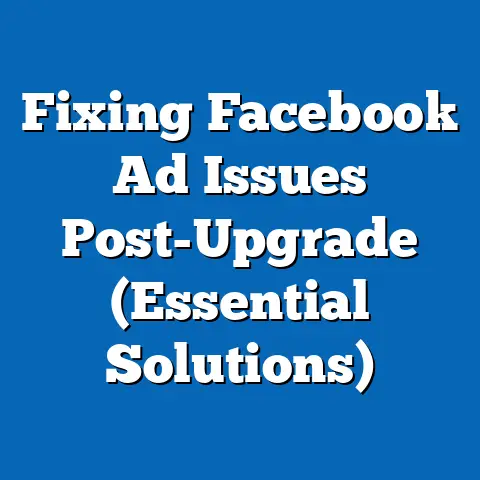Master Facebook Ads Billing Changes (Essential Guide)
Navigating the ever-shifting landscape of digital marketing can feel like trying to assemble a puzzle with pieces constantly changing shape. Facebook Ads, a cornerstone of many marketing strategies, adds its own layer of complexity with its ever-evolving billing structure. As marketers, we invest time, effort, and, most importantly, budget into these campaigns. Understanding the nuances of Facebook Ads billing isn’t just a nice-to-have; it’s an absolute necessity. A misstep here can quickly erode your ROI, leading to wasted ad spend and missed opportunities.
I’ve seen firsthand how crucial it is to stay informed. I remember working with a small e-commerce business that was experiencing unexpected budget overruns. A deep dive into their billing settings revealed they hadn’t adjusted their payment thresholds after a significant campaign scale-up. The result? Multiple small charges throughout the day were racking up, and they were missing out on the potential savings from consolidating those charges into fewer, larger transactions.
This article isn’t just a theoretical overview; it’s a practical guide designed to help you master Facebook Ads billing changes. I’ll walk you through everything from the fundamental billing structure to the latest updates, their implications, and the best practices to navigate them effectively. You’ll learn how to optimize your ad spend, avoid common billing pitfalls, and stay ahead of the curve in this dynamic advertising environment. Let’s dive in!
Overview of Facebook Ads Billing Structure
Before we delve into the recent changes, let’s establish a solid foundation by understanding the core components of Facebook Ads billing. The billing structure is designed to be flexible, catering to various advertising needs and budget sizes.
How Costs Are Calculated: CPC, CPM, CPA
Facebook Ads operates on several bidding models, each influencing how your costs are calculated:
- Cost Per Click (CPC): You pay each time someone clicks on your ad. This is ideal if your primary goal is to drive traffic to your website or landing page.
- Cost Per Mille (CPM): You pay for every 1,000 impressions your ad receives. This is best suited for brand awareness campaigns where you want your ad to be seen by as many people as possible. Mille is Latin for 1,000.
- Cost Per Action (CPA): You pay when a specific action, like a purchase or a lead form submission, is completed as a result of your ad. This is typically used for conversion-focused campaigns.
It’s important to note that Facebook’s algorithm dynamically adjusts these costs based on factors like ad relevance, competition, and audience targeting. This means that your actual costs can vary, and continuous monitoring is crucial.
- Personal Story: I once ran a campaign targeting a highly competitive niche. Initially, my CPC was quite high. By refining my audience targeting and improving my ad relevance score, I managed to significantly reduce the CPC, resulting in a more efficient ad spend.
Manual vs. Automatic Payments
Facebook offers two primary payment options:
- Automatic Payments: This is the most common option. Facebook automatically charges your payment method when you reach your billing threshold or at the end of the month, whichever comes first.
- Manual Payments: You add funds to your ad account before running your ads. As your ads run, Facebook deducts the costs from your available balance. This option is useful for closely controlling your spending and avoiding unexpected charges.
Choosing between these options depends on your budgeting preferences and risk tolerance. Automatic payments offer convenience, while manual payments provide more control.
Billing Cycle and Payment Thresholds
Understanding the billing cycle and payment thresholds is key to managing your ad spend effectively:
- Billing Cycle: This is typically monthly, but it can vary depending on your spending habits and payment history.
-
Payment Thresholds: Facebook sets a threshold for your account. Each time your ad spend reaches this threshold, Facebook charges your payment method. As you consistently pay your bills on time, Facebook may gradually increase your threshold.
-
Example: Let’s say your initial threshold is $25. Once your ad spend reaches $25, Facebook will charge your card. If you consistently pay on time, your threshold might increase to $50, then $100, and so on.
Payment Thresholds: Facebook sets a threshold for your account. Each time your ad spend reaches this threshold, Facebook charges your payment method. As you consistently pay your bills on time, Facebook may gradually increase your threshold.
Example: Let’s say your initial threshold is $25. Once your ad spend reaches $25, Facebook will charge your card. If you consistently pay on time, your threshold might increase to $50, then $100, and so on.
Being aware of your billing cycle and thresholds allows you to anticipate charges and ensure you have sufficient funds available. I recommend setting up billing notifications to stay informed about your spending and upcoming charges.
Takeaway: Familiarize yourself with the core components of Facebook Ads billing, including the different cost calculation methods, payment options, and billing cycle. Choose the payment option that best aligns with your budgeting preferences, and always monitor your spending to avoid surprises.
Recent Changes in Facebook Ads Billing
The digital advertising landscape is in constant flux, and Facebook Ads billing is no exception. Staying abreast of the latest changes is essential for maintaining a competitive edge. I’ll break down the most significant updates I’ve observed, particularly those relevant as of late 2023 and early 2024.
Enhanced Billing Transparency
One notable shift is Facebook’s increased focus on billing transparency. They’ve rolled out improvements to the Ads Manager interface, making it easier to understand where your money is going.
- Detailed Breakdown: You can now access a more granular breakdown of your ad spend, including costs associated with specific campaigns, ad sets, and even individual ads.
-
Improved Reporting: Facebook has enhanced its reporting tools to provide more detailed insights into your billing activity. This includes clearer explanations of charges, adjustments, and taxes.
-
My Experience: I’ve found these enhancements invaluable for quickly identifying underperforming campaigns and reallocating budget to more effective strategies. The increased transparency has also helped me justify ad spend to clients with greater confidence.
Improved Reporting: Facebook has enhanced its reporting tools to provide more detailed insights into your billing activity. This includes clearer explanations of charges, adjustments, and taxes.
My Experience: I’ve found these enhancements invaluable for quickly identifying underperforming campaigns and reallocating budget to more effective strategies. The increased transparency has also helped me justify ad spend to clients with greater confidence.
Updates to Payment Methods
Facebook is continually expanding the range of accepted payment methods to cater to a global audience. Recent additions include:
Changes in Billing Frequency
While the standard monthly billing cycle remains, Facebook has introduced more flexibility in billing frequency for some advertisers.
- Dynamic Thresholds: As mentioned earlier, Facebook adjusts your billing threshold based on your spending habits and payment history. However, they’ve also implemented dynamic thresholds that can fluctuate based on your campaign performance.
- Real-Time Billing: In certain cases, Facebook may charge your payment method in real-time as your ads run, especially if you’re spending a significant amount of money daily.
These changes aim to ensure that advertisers have sufficient funds available to support their campaigns and to prevent fraudulent activity.
Policy Updates Affecting Billing
Facebook regularly updates its advertising policies, and these updates can sometimes have a direct impact on billing. For example:
- Restrictions on Certain Ad Types: If your ads violate Facebook’s policies, they may be disapproved, and you may be charged for impressions or clicks that occurred before the disapproval.
- Changes to Tax Policies: Facebook may update its tax policies to comply with local regulations. This can affect the amount of taxes you’re charged on your ad spend.
Staying informed about these policy updates is crucial for avoiding unexpected charges and ensuring your ads remain compliant.
Takeaway: Keep a close eye on Facebook’s official announcements and help center for the latest updates to its billing system. Take advantage of the enhanced billing transparency to monitor your ad spend more effectively.
Implications of Billing Changes for Advertisers
The changes I’ve just outlined aren’t just technical tweaks; they have real-world implications for how we plan and execute our Facebook ad campaigns. Let’s explore some of the key impacts.
Impact on Budgeting and Forecasting
The increased billing transparency and dynamic thresholds can make budgeting and forecasting more complex.
- More Granular Data: On the one hand, the detailed breakdown of ad spend allows for more accurate budgeting. You can see exactly how much each campaign, ad set, and ad is costing you, making it easier to allocate resources effectively.
- Unpredictable Thresholds: On the other hand, the dynamic billing thresholds can make it harder to predict when you’ll be charged. This can impact your cash flow, especially if you’re running large-scale campaigns.
To mitigate these challenges, I recommend using Facebook’s reporting tools to track your spending trends and adjust your budget accordingly. It’s also a good idea to set up budget alerts to notify you when you’re approaching your spending limits.
Potential Challenges and How to Overcome Them
Advertisers may face several challenges due to these billing changes:
- Cash Flow Issues: Unexpected charges due to dynamic thresholds or policy violations can strain your cash flow. To avoid this, maintain a buffer in your advertising budget and monitor your spending closely.
- Unexpected Charges: Policy violations or discrepancies in billing can lead to unexpected charges. Regularly review your ad policies and double-check your billing statements for any errors.
-
Currency Conversion Fees: If you’re advertising in multiple countries, currency conversion fees can eat into your budget. Consider using local payment methods or negotiating with your bank for better exchange rates.
-
Case Study: I worked with a client who was running ads in several European countries. They were incurring significant currency conversion fees. By switching to local payment methods and negotiating a better exchange rate with their bank, they managed to reduce their currency conversion costs by 15%.
Currency Conversion Fees: If you’re advertising in multiple countries, currency conversion fees can eat into your budget. Consider using local payment methods or negotiating with your bank for better exchange rates.
Case Study: I worked with a client who was running ads in several European countries. They were incurring significant currency conversion fees. By switching to local payment methods and negotiating a better exchange rate with their bank, they managed to reduce their currency conversion costs by 15%.
Adapting to the Changes: Strategic Planning
Adapting to these billing changes requires a strategic approach:
- Regular Monitoring: Monitor your ad spend and billing activity regularly to identify any issues or discrepancies.
- Policy Compliance: Stay up-to-date with Facebook’s advertising policies and ensure your ads are compliant to avoid unexpected charges.
- Budget Flexibility: Build flexibility into your advertising budget to accommodate unexpected charges or changes in billing thresholds.
- Data-Driven Decisions: Use Facebook’s reporting tools to track your spending trends and make data-driven decisions about your budget allocation.
Takeaway: The billing changes in Facebook Ads have significant implications for budgeting, forecasting, and cash flow management. By adopting a strategic approach and monitoring your ad spend closely, you can overcome these challenges and maximize your advertising ROI.
Best Practices for Managing Facebook Ads Billing
Now that we’ve covered the changes and their implications, let’s discuss some best practices for managing your Facebook Ads billing effectively. These tips will help you stay in control of your ad spend and avoid common pitfalls.
Monitoring Spend and Understanding Billing Notifications
Regularly monitoring your ad spend and understanding billing notifications are crucial for effective billing management.
- Set Up Budget Alerts: Facebook allows you to set up budget alerts that notify you when you’re approaching your spending limits. This helps you avoid overspending and stay within your budget.
- Review Billing Statements Regularly: Take the time to review your billing statements regularly to identify any discrepancies or unexpected charges.
- Understand Billing Notifications: Familiarize yourself with the different types of billing notifications Facebook sends and what they mean. This will help you stay informed about your spending and upcoming charges.
Leveraging Facebook’s Reporting Tools
Facebook’s reporting tools provide valuable insights into your ad spend and campaign performance.
- Track Expenditures: Use the reporting tools to track your expenditures over time and identify any trends or patterns.
- Optimize Ad Spend: Analyze your campaign performance data to identify underperforming campaigns and reallocate budget to more effective strategies.
-
Understand Billing Cycles: Use the reporting tools to understand your billing cycles and payment thresholds. This will help you anticipate charges and ensure you have sufficient funds available.
-
Pro Tip: Create custom reports that focus on key metrics like cost per click, cost per conversion, and return on ad spend. This will give you a clear picture of your campaign performance and help you make informed decisions about your budget allocation.
Understand Billing Cycles: Use the reporting tools to understand your billing cycles and payment thresholds. This will help you anticipate charges and ensure you have sufficient funds available.
Pro Tip: Create custom reports that focus on key metrics like cost per click, cost per conversion, and return on ad spend. This will give you a clear picture of your campaign performance and help you make informed decisions about your budget allocation.
Optimizing Ad Spend Based on Billing Cycles
Optimizing your ad spend based on billing cycles can help you maximize your advertising ROI.
- Adjust Budget Based on Performance: If you notice that your campaigns are performing well, consider increasing your budget to take advantage of the momentum. Conversely, if your campaigns are underperforming, consider reducing your budget or pausing them altogether.
- Plan for Peak Seasons: During peak seasons like holidays or special events, you may want to increase your budget to capitalize on increased demand.
- Monitor Billing Thresholds: As your billing threshold increases, you may want to adjust your budget to take advantage of the higher spending limit.
Takeaway: By monitoring your ad spend, leveraging Facebook’s reporting tools, and optimizing your ad spend based on billing cycles, you can effectively manage your Facebook Ads billing and maximize your advertising ROI.
Resources for Staying Updated on Billing Changes
The world of Facebook Ads is constantly evolving, so staying informed about billing changes is an ongoing process. Here are some resources to help you stay up-to-date:
Facebook’s Official Help Center
The Facebook Help Center is your first stop for information about billing changes.
- Comprehensive Documentation: The Help Center provides comprehensive documentation on all aspects of Facebook Ads billing, including payment options, billing cycles, and troubleshooting tips.
- Frequently Asked Questions: The Help Center also includes a frequently asked questions (FAQ) section that addresses common billing issues.
- Search Functionality: Use the search functionality to quickly find information about specific billing topics.
Community Forums
Facebook’s community forums are a great place to connect with other advertisers and share information about billing changes.
- Ask Questions: If you have a question about billing changes, post it in the community forums and get answers from other advertisers.
- Share Tips: Share your own tips and experiences with managing Facebook Ads billing.
- Stay Informed: Keep an eye on the forums to stay informed about the latest billing changes and best practices.
Industry Blogs and Influencers
Many industry blogs and influencers focus on Facebook marketing and advertising.
- Follow Key Influencers: Follow key influencers on social media to stay informed about the latest trends and best practices in Facebook Ads billing.
- Read Industry Blogs: Subscribe to industry blogs to receive updates on billing changes and other important topics.
-
Attend Webinars: Attend webinars and online events to learn from experts and stay up-to-date on the latest billing strategies.
-
Recommendations: Some of my go-to sources include the Facebook Business Blog, Social Media Examiner, and Jon Loomer Digital. These resources consistently provide valuable insights and updates on Facebook Ads.
Attend Webinars: Attend webinars and online events to learn from experts and stay up-to-date on the latest billing strategies.
Recommendations: Some of my go-to sources include the Facebook Business Blog, Social Media Examiner, and Jon Loomer Digital. These resources consistently provide valuable insights and updates on Facebook Ads.
Takeaway: Stay informed about Facebook Ads billing changes by utilizing Facebook’s official Help Center, participating in community forums, and following industry blogs and influencers.
Conclusion
Mastering Facebook Ads billing changes is an ongoing process, but it’s one that’s essential for any advertiser who wants to maximize their ROI and stay ahead of the curve. By understanding the core components of Facebook Ads billing, staying informed about the latest changes, and implementing the best practices outlined in this article, you can effectively manage your ad spend and achieve your advertising goals.
Remember, the key is to be proactive, not reactive. Regularly monitor your ad spend, review your billing statements, and stay up-to-date on Facebook’s advertising policies. By doing so, you can avoid unexpected charges, optimize your budget allocation, and ensure that your advertising campaigns are as effective as possible.
I encourage you to share your experiences and thoughts on Facebook Ads billing changes in the comments below or on social media. Let’s learn from each other and help each other navigate the ever-evolving world of Facebook advertising. And if you have any questions or need further assistance, don’t hesitate to reach out. Together, we can master Facebook Ads billing and achieve our advertising goals.






